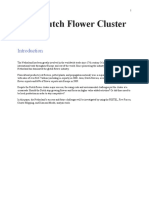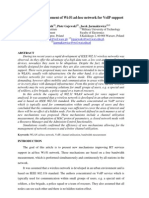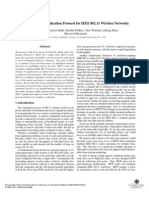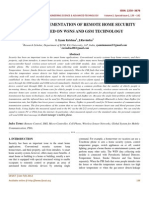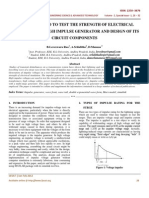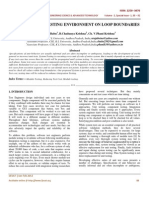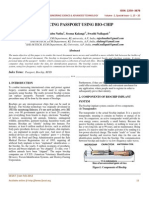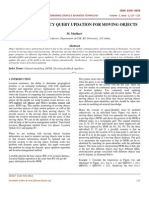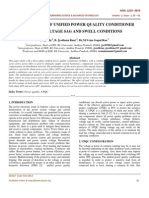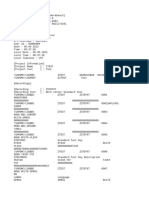Impact Aggregation of Ethernet Frames For Higher Throughput
Impact Aggregation of Ethernet Frames For Higher Throughput
Uploaded by
Ijesat JournalCopyright:
Available Formats
Impact Aggregation of Ethernet Frames For Higher Throughput
Impact Aggregation of Ethernet Frames For Higher Throughput
Uploaded by
Ijesat JournalOriginal Title
Copyright
Available Formats
Share this document
Did you find this document useful?
Is this content inappropriate?
Copyright:
Available Formats
Impact Aggregation of Ethernet Frames For Higher Throughput
Impact Aggregation of Ethernet Frames For Higher Throughput
Uploaded by
Ijesat JournalCopyright:
Available Formats
KONDALARAO.PUNATI* et al.
[IJESAT] INTERNATIONAL JOURNAL OF ENGINEERING SCIENCE & ADVANCED TECHNOLOGY
ISSN: 22503676
Volume-2, Special Issue-1, 111 116
IMPACT AGGREGATION OF ETHERNET FRAMES FOR HIGHER THROUGHPUT
Kondalarao.Punati1, G. Subramanya Sarma2, Naresh Kumar Reddy.Beechu3
1
Research Scholar, ECM Department, K.L.University, A.P, India, kondalarao.punati@gmail.com 2 Assitant Professor, ECM Department, K.L.University, A.P, India, sarma_g_s@ yahoo.com 3 Research Scholar, ECM Department, K.L.University, A.P, India, naresh.klu @ gmail.com
Abstract
In this work describes the impact frame aggregation scheme which improves throughput performance. Aggregating multiple Ethernet frames into single transmission to improve the network efficiency of WLAN by using IEEE802.11n . IEEE802.11n is the latest amendment that aims to achieve throughput higher than 100 mbps at MAC layer. Two aggregation schemes have been defined by the 802.11n standard. Our novel concept simulation results confirm that two frame aggregation schemes are A-MSDU(Aggregation of MAC service data unit) ,A-MPDU(Aggregation of MAC protocol data unit) and combination of two methods also improves channel efficiency and throughput. In this paper We are going to analyze the performance of the each frame in different scenarios and finally we conclude that two level aggregation is most efficient.
Index Terms: 802.11n, A-MSDU, A-MPDU, Two level Frame Aggregation, WLAN -----------------------------------------------------------------------***----------------------------------------------------------------------1. INTRODUCTION
Over the last decade, the applications of wireless and cellular devices have expanded rapidly. The most popular network in the wireless domain is the IEEE 802.11 wireless local area network (WLAN) [1] mainly because of the advantages that its systems possess. Its key characteristics, such as interoperability, mobility, flexibility, and cost-effective deployment, have led to its gaining vast support across enterprises, the public sector, homes, and data service providers. The IEEE 802.11n enhances both MAC and PHY layer to support higher data rates, better coverage, and backward compatibility with legacy devices. The use of multiple input multiple output (MIMO) technology along with OFDM (MIMO-OFDM) and doubling of the channel bandwidth from 20 MHz to 40 MHz helps increase the data rate of the PHY layer up to 600 Mbps. Frame aggregation and enhanced block ack are the most important new MAC layer features in IEEE 802.11n. Apart from these enhancements, there are plenty of optional MAC features. Some of them include advanced power save techniques and the ability to reserve the medium for a bidirectional link [2-3]. However, the low efficiency of its medium access control (MAC) and physical (PHY) layer protocols restricts its applications to support high data rate multimedia services. Current WLAN systems endure difficulties with the increasing expectations of end users and with volatile bandwidth and delay-boundary demands from new higher data rate services, such as high-definition televisions(HDTV), video teleconferencing, multimedia streaming, voice over IP (VoIP), file transfer, and online gaming. In July 2002, the IEEE 802.11 standard working group established the HighThroughput Study Group (HTSG) with the aim to achieve higher data rate solutions by means of existing PHY and MAC mechanisms [4, 5]. Its first interest was to achieve a MAC data throughput over 100 Mb/s using the 802.11a standard. However, the objective proved to be infeasible as the estimated throughput bounds are well below the theoretical maximum link rate because of the existing MAC and PHY overhead [6,7]. So, in September 2003, the HTSG set off the IEEE 802.11n (n represents next-generation) resolution to compose a high-throughput (HT) extension of the current WLAN standard that will increase transmission rate and reduce compulsory overhead. The main goal of the IEEE 802.11n Task Group (TGn) is to define an amendment that will have maximum data throughput of at least 100 Mb/s, as measured at the MAC data service access point (SAP), and at the same time, to allow coexistence with legacy devices. In this article we mainly focus on the MAC frame aggregation methods that TGn has proposed in the latest 802.11n standard draft, and how these can improve WLANs by way of higher
IJESAT | Jan-Feb 2012
Available online @ http://www.ijesat.org 111
KONDALARAO.PUNATI* et al. [IJESAT] INTERNATIONAL JOURNAL OF ENGINEERING SCIENCE & ADVANCED TECHNOLOGY throughput and maximized efficiency. Thus, we begin with a brief outline of the current IEEE802.11 WLAN standards, followed by a discussion of its maximal throughput limitations because of overhead. We then concentrate on the latest work of 802.11n on both PHY and MAC. We also evaluate, via simulations, the improved performance when using frame aggregation and its efficiency over distinct scenarios. Finally, we conclude by summarizing this articles findings. the MAC header.
ISSN: 22503676
Volume-2, Special Issue-1, 111 116
2. AGGRIGATION IN IEEE802.11N
Increasing the data rate of PHY layer alone is not sufficient to achieve the desired MAC layer throughput of more than 100 Mbps due to rate independent overheads [8]. To overcome this issue, frame aggregation at the MAC layer is proposed in 802.11n to improve the efficiency. There are two types of aggregation defined in IEEE 802.11n [2-3] which are listed below and combination of two techniques at two level frame aggregation scheme explained. Aggregate-MSDU (A-MSDU) Aggregate-MPDU (A-MPDU)
Figure 2a describes a simple structure of a carrier MPDU that contains an A-MSDU. Each sub frame consists of a sub frame header followed by the packet that arrived from the LLC and 0 3 bytes of padding. The padding size depends on the rule that each sub frame, except for the last one, should be a multiple of four bytes, so the end receiver can approximate the beginning of the next sub frame. A major drawback of using AMSDU is under error-prone channels. By compressing all MSDUs into a single MPDU with a single sequence number, for any sub frames that are corrupted, the entire A-MSDU must be retransmitted. This situation has been addressed in [7,9], where additional frame structures or optimum frame sizes have been proposed to improve performance under noisy channels.
2.1 A-MSDU
The principle of the A-MSDU (or MSDU aggregation) is to allow multiple MSDUs to be sent to the same receiver concatenated in a single MPDU. This definitely improves the efficiency of the MAC layer, specifically when there are many small MSDUs, such as TCP acknowledgments. This supporting function for A-MSDU within the 802.11n is mandatory at the receiver. For an A-MSDU to be formed, a layer at the top of the MAC receives and buffers multiple packets (MSDUs). The A-MSDU is completed either when the size of the waiting packets reaches the maximal A-MSDU threshold or the maximal delay of the oldest packet reaches a pre-assigned value. Its maximum length can be either 3839 or 7935 bytes; this is 256 bytes shorter than the maximum PHY PSDU length (4095 or 8191 bytes, respectively), as predicted space is allocated for future status or control information. The size can be found in the HT capabilities element that is advertised from an HT STA in order to declare its HT status. The maximal delay can be set to an independent value for every AC but is usually set to 1 s for all ACs. There are also certain constraints when constructing an A-MSDU: All MSDUs must have the same TID value Lifetime of the A-MSDU should correspond to the maximum lifetime of its constituent elements The destination address (DA) and sender address (SA) parameter values in the sub frame header must match to the same receiver address (RA) and transmitter address (TA) in
Fig.2a.A-MSDU
2.2 A-MPDU
The concept of A-MPDU aggregation is to join multiple MPDU sub frames with a single leading PHY header. A key difference from A-MSDU aggregation is that A-MPDU functions after the MAC header encapsulation process. Consequently, the A-MSDU restriction of aggregating frames with matching TIDs is not a factor with A-MPDUs. However, all the MPDUs within an A-MPDU must be addressed to the same receiver address. Also, there is no waiting holding time to form an A-MPDU so the number of MPDUs to be aggregated totally depends on the number of packets already in the transmission queue. The maximum length that an A-
IJESAT | Jan-Feb 2012
Available online @ http://www.ijesat.org 112
KONDALARAO.PUNATI* et al. [IJESAT] INTERNATIONAL JOURNAL OF ENGINEERING SCIENCE & ADVANCED TECHNOLOGY MPDU can obtain in other words the maximum length of the PSDU that may be received is 65,535 bytes, but it can be further constrained according to the capabilities of the STA found in the HT capabilities element. The utmost number of sub frames that it can hold is 64 because a block ACK bitmap field is 128 bytes in length, where each frame is mapped using two bytes. Note that these two bytes are required to acknowledge up to 16 fragments but because A-MPDU does not allow fragmentation, these extra bits are excessive. As a result, a new variant has been implemented, known as compressed block ACK with a bitmap field of eight bytes long. Finally, the size of each sub frame is limited to 4095 bytes as the length of a PPDU cannot exceed the 5.46-ms time limit; this can be derived from the maximum length divided by the lowest PHY rate, which is 6 Mb/s and is the highest duration of an MPDU in 802.11a. The basic structure is shown in Fig. 2b. A set of fields, known as delimiters are inserted before each MPDU and padding bits varied from 0 3 bytes are added at the tail. The basic operation of the delimiter header is to define the MPDU position and length inside the aggregated frame. It is noted that the cyclic redundancy check (CRC) field in the delimiter verifies the authenticity of the 16 preceding bits. The padding bytes are added such that each MPDU is a multiple of four bytes in length, which can assist sub frame delineation at the receiver side.
ISSN: 22503676
Volume-2, Special Issue-1, 111 116
it checks every four bytes until it locates a valid delimiter or the end of the PSDU. The delimiter signature has a unique pattern to assist the de-aggregation process while scanning for delimiters.
2.3 Two-Level Aggregation
A two-level frame aggregation comprises a blend of A-MSDU and AMPDU over two stages. In Fig. 3 we illustrate how this new scheme can be achieved. The basic operation is explained as follows. In the first stage, if any MSDUs that are buffered in the A-MSDU provisional storage area justify the A-MSDU constraints explained in the previous related subsection, these data units can be compacted into a single A-MSDU.
Fig 3 Two level aggregation Fig .2b.A-MPDU In other words, the MPDU delimiters and PAD bytes determine the structure of the A-MPDU. After the AMPDU is received, a de-aggregation process initiates. First it checks the MPDU delimiter for any errors based on the CRC value. If it is correct, the MPDU is extracted, and it continues with the next sub frame till it reaches the end of the PSDU. Otherwise, If the TIDs are different, all these aberrant frames can move to the second stage where they will be packed together with any A-MSDUs derived from the first stage or other single MSDUs by using A-MPDU aggregation. However, it must be mentioned that given that the maximum MPDU length for an A-MPDU data frame is limited to 4095 bytes, then A-MSDUs or MSDUs with lengths larger than this threshold cannot be transmitted. Conjointly, any fragments from an A-MSDU or
IJESAT | Jan-Feb 2012
Available online @ http://www.ijesat.org 113
KONDALARAO.PUNATI* et al. [IJESAT] INTERNATIONAL JOURNAL OF ENGINEERING SCIENCE & ADVANCED TECHNOLOGY MSDUs also cannot be included in an A-MPDU. In the following section, we evaluate how this synthesis is more efficient in most of the cases than A-MPDU and A-MSDU aggregation operating alone.
ISSN: 22503676
Volume-2, Special Issue-1, 111 116
aggregate several small packets within a single MPDU, even if the length is limited to 4 KB; the same way that A-MPDU can place multiple MPDUs in a single PSDU. Thus, for small packet sizes, we can choose any type of aggregation.
3. SIMULATION SCENARIOS
The IEEE 802.11n Task Group has predefined specific usage models [10] based on various market based use cases. The usage models intend to support the definitions of network simulations that will allow them to evaluate performance of various proposals in terms of, for example, network throughput, delay, packet loss, and other metrics. In this subsection, we test the efficiency of aggregation over two high throughput stations. This scenario also is known by the TGn as Scenario (point-to-point good put test). Here, we study the maximum throughput for each proposed aggregating scheme while increasing the offered load or when the load remains constant but the packet size is increasing. From these scenarios, we also can observe the degrading channel efficiency when aggregation is disabled, and the system uses in full its latest PHY techniques (e.g., MIMO).
3.1 Simulation Results And Discussion
Figure 4 illustrates the throughput results (in Mb/s) obtained from the MAC SAP while the offered load (OL) from the associated HT STA accumulates gradually. For the frame aggregation, we define four different settings: Both A-MPDU and A-MSDU are enabled Only the A-MPDU algorithm is used Only the A-MSDU algorithm is used No aggregation at all In the first simulation, the OL is incremented by just varying the packet size while keeping the constant packet generation interval, also known as the constant packet rate (CPR), which is 40 s. The initial OL is 25 Mb/s, and it increases up to 300 Mb/s with the increase of packet size (i.e., 125/250/500/750/1000/1500 bytes). For each case, the traffic generation rate is configured high enough to saturate the air link rate that corresponds to the PHY peak (144 Mb/s) on each figure, and the maximal A-MSDU length is 4 KB. As shown in Fig. 4, we observe that all throughputs increase according to the load. In general, as the packet size increases, the AMSDU stays below 75 Mb/s, while A-MPDU and the two-level aggregation achieve maximum throughputs of 136 and 134 Mb/s, respectively. When the packet size maintains values of 125 B (see OL = 25 Mb/s) and 250 B (see OL = 50 Mb/s), the corresponding throughputs for any type of aggregation are similar. This is because A-MSDU can
Fig 4. Throughput vs Increased offered load by varying the packet size. On the other hand, when the packet size is larger than 250 KB, the throughput of A-MSDU distinguishes significantly from AMPDU and the two-layer aggregation, with much lower values because the number of MSDUs that fit into a single AMSDU is becoming less than the other cases. We can monitor this behavior even more closely when packet size increases from 1000 B (see OL = 200 Mb/s) to 1500 B (see OL = 300 Mb/s). The A-MSDU throughput drops slightly for the reason that we had four packets of 1000 B, fitting in one AMSDU, where in the case of 1500 B packet size, only two of them can occupy the same space. The same behavior occurs with the two-level aggregation but only because of the A-MSDU stage. This is also why the A-MPDU throughput increases further when two-level aggregation remains at the same levels. The throughput for the no-aggregation case always increases with the increase of the OL by varying the packet size even after the channel is saturated. However, by only increasing the packet size up to the maximum Ethernet transmission unit (1500 bytes), without aggregation, will achieve throughput about three times lower than that of the AMPDU and the twolevel aggregation. This clearly demonstrates that small packet size is the key factor that lowers the throughput efficiency. In the second simulation, we increase the OL by altering the packet inter arrival rate, that is, variable packet rate (VPR), instead of increasing the packet sizes. So the packet size remains constant at 1,000 B during the simulation test. From Fig. 5, we can observe that the MAC throughput performance
IJESAT | Jan-Feb 2012
Available online @ http://www.ijesat.org 114
KONDALARAO.PUNATI* et al. [IJESAT] INTERNATIONAL JOURNAL OF ENGINEERING SCIENCE & ADVANCED TECHNOLOGY of all the schemes first increases with an increase of the OL. However, after channel is saturated, the throughput of all the schemes remains constant even when the OL keeps increasing, which is different from the first simulation. This behavior is characterized as normal because of channel saturation, meaning the resources are limited to the impending demand. Furthermore, the throughput achieved by the AMPDU and the two-level aggregation after saturation is approximately 4.5 times higher than the no aggregation scheme.
ISSN: 22503676
Volume-2, Special Issue-1, 111 116
this blend of A-MSDU and A-MPDU, in most cases, is capable of improving the effectiveness of the MAC layer, specifically when there are many small MSDUs, such as TCP acknowledgments. For example, when the packet size is set for 125 B, there are approximately 999,800 MSDUs generated during the simulation period. In spite of this, the number of MPDUs received at the receiver is 34,500 MPDUs, and that suggests that a huge MAC and PHY overhead was avoided. For the largest packet size of 1500 B, there are approximate 83,300 indicated MSDUs and about 41,650 received MPDUs, a 50 percent improvement in efficiency.
Fig 5. Throughput vs. increased offered load by varying the packet arrival interval (packet size = 1 kbyte). The last simulation represents a scenario for a fixed OL of 100 Mb/s with variant packet sizes and appropriate interval times. In this simulation, there is no channel saturation. Along with the throughput values for each type of aggregation, we investigate the degree of aggregation that the two-level aggregation performs, by comparing the number of indicated MSDUs and the received MPDUs. In Fig. 6, the A-MPDU and the two-level aggregation achieve the 100 Mb/s goal that TGn has set, whereas A-MSDU falls below that threshold at around 75 Mb/s. In conclusion, although the A-MSDU mechanism can achieve higher throughput than the legacy 802.11 standards, it does not utilize the channel as fully as A-MPDU and the two-level aggregation do. However, there is an exception for the AMPDU function when packet size is 125 B and packet rate is 10 s each. This shows that this type of aggregation cannot handle the bulk traffic effectively, and thus, a lower throughput than the two-level aggregation because the AMSDU algorithm facilitates to overcome that issue at the first stage of aggregation. It is very important to understand how
Figure 6. Throughput vs. increased MSDU size.
4. CONCLUSION
This work investigates several frame aggregation schemes proposed in the latest IEEE 802.11n draft, namely, A-MSDU, A-MPDU, and the combined two-level aggregation. Our simulation results demonstrated that concatenation mechanisms performed over different sub layers can actually increase the channel efficiency and reduce the overhead of the future 802.11 MAC. All types of aggregation schemes are highly recommended as they resolve the fundamental problem of inefficiency due to the PHY/MAC overhead. However, the IEEE 802.11n draft only identifies the basic concepts and data frame structures. In a flawless environment, it can deliver attractive results but in terms of its functionality in a real working environment, there are still many issues that require further investigation. Future work includes examining multi destination aggregation, frame aggregation performing over error-prone channels, and the co-existence of HT stations with the legacy ones.
IJESAT | Jan-Feb 2012
Available online @ http://www.ijesat.org 115
KONDALARAO.PUNATI* et al. [IJESAT] INTERNATIONAL JOURNAL OF ENGINEERING SCIENCE & ADVANCED TECHNOLOGY
ISSN: 22503676
Volume-2, Special Issue-1, 111 116
REFERENCES
[1] IEEE Std 802.11 WG, Part 11: Wireless LAN Medium Access Control (MAC) and Physical Layer (PHY) Specifications, Aug. 1999. [2] IEEE 802.11n, Draft 4.0 - Wireless LAN Media Access Control (MAC) and Physical Layer (PHY) Specifications: Enhancements for Higher Throughput, IEEE, March 2008. [3] IEEE 802.11n, Draft 2.0 - Wireless LAN Media Access Control (MAC) and Physical Layer (PHY) Specifications: Enhancements for Higher Throughput, IEEE, February 2007. [4] V. Jones, R. DeVegt, and T. Jerry, Interest for Higher Data Rates (HDR)Extension to 802.11a, IEEE 802.11n working doc. 802.11-02-081r0,Jan 2002. [5] J. Rosdahl, Draft Project Authorization Request (PAR) for High Throughput Study Group, IEEE 802.11n working doc.802.11- 02/798r2, Mar. 2003. [6] Y. Xiao and J. Rosdahl, Throughput and Delay Limits of IEEE802.11IEEE Commun. Letters, vol. 6, no. 8 Aug. 2002, pp. 35557. [7] Q. Ni et al., AFR partial MAC proposal for IEEE 802.11n, IEEE802.11n working doc. 802.11-04-0950- 00000n, Aug. 2004. [8] IEEE Std. 802.11g WG, Part 11: Wireless LAN Medium Access Control (MAC) and physical layer (PHY) specifications: further High data rate extension in the 2.4GHz band, June 2003. [9] Y. Lin and V. Wong, Frame Aggregation and Optimal frame size Adaptation for IEEE 802.11n WLANs, Proc. IEEE GLOBECOM, San Francisco, CA, Nov. 2006, pp. 16. [10] A. P. Stephens et al., IEEE P802.11 Wireless LANs: Usage Models,IEEE802.11n working doc. 802.11-03/802r23, May 2004.
2004 and 2008 respectively. He is working as Assistant Professor in K.L.University. Naresh Kumar Reddy.Beechu: He received B.Tech from S.V. University, Thirupathi in 2010 and M.Tech pusuing from K.L.University, vaddeswaram. His intrest focus on Embedded systems.
BIOGRAPHIES
Kondalarao.Punati: He received B.E from Anna University, Chennai in 2009. M.Tech Pursuing from K.L.University, Vaddeswaram.His intrest focus on Embedded systems. G. Subramanya Sarma: He received M.Sc from Nagarjuna University, Guntur and M.Tech from Nagarjuna University in
IJESAT | Jan-Feb 2012
Available online @ http://www.ijesat.org 116
You might also like
- Indoor Radio Planning: A Practical Guide for 2G, 3G and 4GFrom EverandIndoor Radio Planning: A Practical Guide for 2G, 3G and 4GRating: 5 out of 5 stars5/5 (1)
- Dutch Flower Cluster Case AnalysisDocument13 pagesDutch Flower Cluster Case AnalysisinasNo ratings yet
- A Frame Aggregation Scheduler For IEEE 802 11nDocument5 pagesA Frame Aggregation Scheduler For IEEE 802 11nVanhan HoNo ratings yet
- 802.11 AMPDU and AMSDU Performance 2007Document5 pages802.11 AMPDU and AMSDU Performance 2007Fabian TrumperNo ratings yet
- A Study On Frame Aggregation in Wireless NetworksDocument14 pagesA Study On Frame Aggregation in Wireless Networkspravin2mNo ratings yet
- An Energy Efficient MAC Protocol Based On IEEE 802.11 in Wireless Ad Hoc Networks 2011 Annales Des Telecommunications Annals of TelecommunicationsDocument12 pagesAn Energy Efficient MAC Protocol Based On IEEE 802.11 in Wireless Ad Hoc Networks 2011 Annales Des Telecommunications Annals of TelecommunicationsAmir Hossein YazdavarNo ratings yet
- Ceragon - Jumbo Frames - Technical BriefDocument7 pagesCeragon - Jumbo Frames - Technical BriefBernardo PortillaNo ratings yet
- Enhancing Network Throughput Via The Equal Interval Frame Aggregation Scheme For Ieee 802.11ax WlansDocument13 pagesEnhancing Network Throughput Via The Equal Interval Frame Aggregation Scheme For Ieee 802.11ax Wlansنوري احواسNo ratings yet
- Header Compression: Capacity Calculations For Wireless NetworksDocument10 pagesHeader Compression: Capacity Calculations For Wireless NetworksSeason Scene MaratNo ratings yet
- Performance Impairments in Single-Mode Radio-Over-Fiber Systems Due To MAC ConstraintsDocument9 pagesPerformance Impairments in Single-Mode Radio-Over-Fiber Systems Due To MAC ConstraintsDiptanil DebBarmanNo ratings yet
- Enotes CO3Document14 pagesEnotes CO3Arjun NaiduNo ratings yet
- Research Article: Optimal Configuration of Virtual Links For Avionics Network SystemsDocument10 pagesResearch Article: Optimal Configuration of Virtual Links For Avionics Network Systemsvijaykumar ponugotiNo ratings yet
- Efficient Network Level Beamforming Training For Ieee 802.11ad WlansDocument6 pagesEfficient Network Level Beamforming Training For Ieee 802.11ad Wlansruda64No ratings yet
- LTE PHY Layer Test BedDocument7 pagesLTE PHY Layer Test BedakhilaNo ratings yet
- P A I A P C Mac P (Iapcmp) Manet: Erformance Nalysis of Mproved Utonomous Ower Ontrol Rotocol FOR SDocument11 pagesP A I A P C Mac P (Iapcmp) Manet: Erformance Nalysis of Mproved Utonomous Ower Ontrol Rotocol FOR SijansjournalNo ratings yet
- Liu 2016Document12 pagesLiu 2016نوري احواسNo ratings yet
- 3.4 IEEE 802.11 AmendmentsDocument10 pages3.4 IEEE 802.11 AmendmentsCathyFer Valles YanezNo ratings yet
- Ceragon Header Compression - Technical Brief PDFDocument9 pagesCeragon Header Compression - Technical Brief PDFyassminbgNo ratings yet
- 31 - JCIT - JUNE - Binder1-31Document8 pages31 - JCIT - JUNE - Binder1-31Aditya WijayantoNo ratings yet
- دورة الرسالةDocument17 pagesدورة الرسالةنوري احواسNo ratings yet
- Steganography in Long Term Evolution Systems: Iwona Grabska, Krzysztof SzczypiorskiDocument8 pagesSteganography in Long Term Evolution Systems: Iwona Grabska, Krzysztof SzczypiorskiAjay Kumar SwarnkarNo ratings yet
- IEEE 802.11 AxDocument9 pagesIEEE 802.11 AxNarminAlmaznaNo ratings yet
- 802.15.4 Simulation in Omnet++Document4 pages802.15.4 Simulation in Omnet++Ahmed HanyNo ratings yet
- Session 25,26Document14 pagesSession 25,26Arjun NaiduNo ratings yet
- Wi-Fi Capacity Analysis WP PDFDocument21 pagesWi-Fi Capacity Analysis WP PDFkomalNo ratings yet
- A Review of Load Balancing Techniques in LTEDocument5 pagesA Review of Load Balancing Techniques in LTEossridNo ratings yet
- Performance Enhancement of High Speed WlansDocument9 pagesPerformance Enhancement of High Speed Wlanspiyushji125No ratings yet
- Performance Enhancement of High Speed WlansDocument10 pagesPerformance Enhancement of High Speed Wlanspiyushji125No ratings yet
- Throughput and Delay Analysis of Unslotted IEEE 802.15.4Document9 pagesThroughput and Delay Analysis of Unslotted IEEE 802.15.4Faucon MbémbéNo ratings yet
- Performance Enhancement of Wi-Fi Ad-Hoc Network For Voip SupportDocument11 pagesPerformance Enhancement of Wi-Fi Ad-Hoc Network For Voip SupportKaran ReddyNo ratings yet
- Performance Analysis of Uncoded & Coded Ofdm System For Wimax NetworksDocument5 pagesPerformance Analysis of Uncoded & Coded Ofdm System For Wimax NetworksInternational Journal of Application or Innovation in Engineering & ManagementNo ratings yet
- An Adaptive Cross-Layer Design For Multiservice SchedulingDocument9 pagesAn Adaptive Cross-Layer Design For Multiservice Schedulingahmed8790No ratings yet
- Speech Capacity Enhancements in The GSM/EDGE Radio Access Network (GERAN)Document5 pagesSpeech Capacity Enhancements in The GSM/EDGE Radio Access Network (GERAN)pepe_shadeNo ratings yet
- A Configurable Medium Access Control Protocol For IEEE 802.15.4 NetworksDocument8 pagesA Configurable Medium Access Control Protocol For IEEE 802.15.4 NetworksDomRuanNo ratings yet
- Joint Aggregation and MAC Design To Prolong Sensor Network Lifetime - ICNP 2013Document10 pagesJoint Aggregation and MAC Design To Prolong Sensor Network Lifetime - ICNP 2013NgocThanhDinhNo ratings yet
- Using Ad Hoc-Network With IEEE802.11 AcDocument6 pagesUsing Ad Hoc-Network With IEEE802.11 Acعبدالله أبورويصNo ratings yet
- UbiCC 241 241Document12 pagesUbiCC 241 241Ubiquitous Computing and Communication JournalNo ratings yet
- Liu 2015Document4 pagesLiu 2015نوري احواسNo ratings yet
- 5989 2365enDocument36 pages5989 2365enTorsion TesnorNo ratings yet
- Master Thesis On LTE and 5G Full ReportDocument55 pagesMaster Thesis On LTE and 5G Full ReportNancyNo ratings yet
- High-Speed Downlink Packet Access (HSDPA) Is An EnhancedDocument9 pagesHigh-Speed Downlink Packet Access (HSDPA) Is An EnhancedjobertNo ratings yet
- Enabling MAC Protocol Implementations On Software-Defined RadiosDocument15 pagesEnabling MAC Protocol Implementations On Software-Defined RadiosPartha BanerjeeNo ratings yet
- Improving HSDPA Indoor Coverage and Throughput byDocument12 pagesImproving HSDPA Indoor Coverage and Throughput byAbdulla AborweesNo ratings yet
- Practical Issues of Power Control in IEEE 802.11 Wireless DevicesDocument5 pagesPractical Issues of Power Control in IEEE 802.11 Wireless DevicesAxel HammarNo ratings yet
- Long Term Evolution (LTE) : Overview of LTE Air-InterfaceDocument17 pagesLong Term Evolution (LTE) : Overview of LTE Air-InterfaceTarun GuptaNo ratings yet
- Fast ARQ in High Speed Downlink Packet Access For WCDMA SystemsDocument7 pagesFast ARQ in High Speed Downlink Packet Access For WCDMA SystemsTorsion TesnorNo ratings yet
- 100 Gigabit Ethernet: Jenson K A S7 Cs Roll No:17Document26 pages100 Gigabit Ethernet: Jenson K A S7 Cs Roll No:17jensonNo ratings yet
- Buffer Sizing For 802Document12 pagesBuffer Sizing For 802RamJiNo ratings yet
- A Multi-Radio Unification Protocol For IEEE 802.11 Wireless NetworksDocument11 pagesA Multi-Radio Unification Protocol For IEEE 802.11 Wireless NetworksAjinkya KaleNo ratings yet
- An Adaptive Energy-Efficient MAC Protocol For Wireless Sensor NetworksDocument10 pagesAn Adaptive Energy-Efficient MAC Protocol For Wireless Sensor NetworksscribNo ratings yet
- Throughput Comparison Between The New HEW 802.11ax Standard and 802.11n/ac Standards in Selected Distance WindowsDocument6 pagesThroughput Comparison Between The New HEW 802.11ax Standard and 802.11n/ac Standards in Selected Distance WindowsTSIMANDRESY HeriniainaNo ratings yet
- Introduction To MadmDocument42 pagesIntroduction To MadmAravind Teja Mamidi100% (1)
- Ijcnc 050313Document13 pagesIjcnc 050313AIRCC - IJCNCNo ratings yet
- Cluster Based Routing ReportDocument33 pagesCluster Based Routing ReportRupam DasNo ratings yet
- High-Speed Downlink Packet Access: TechnologyDocument7 pagesHigh-Speed Downlink Packet Access: Technologyमनीष सिंहNo ratings yet
- Indjcse12 03 06 074Document5 pagesIndjcse12 03 06 074dodo gogoNo ratings yet
- Energy and Bandwidth Constrained Qos Enabled Routing For ManetsDocument11 pagesEnergy and Bandwidth Constrained Qos Enabled Routing For ManetsAIRCC - IJCNCNo ratings yet
- Improving Throughput Performance of The IEEE 802.11 MAC Layer Using Congestion Control MethodsDocument15 pagesImproving Throughput Performance of The IEEE 802.11 MAC Layer Using Congestion Control MethodsShambhu KhanalNo ratings yet
- Modeling and Dimensioning of Mobile Wireless Networks: From GSM to LTEFrom EverandModeling and Dimensioning of Mobile Wireless Networks: From GSM to LTENo ratings yet
- Ijesat 2012 02 Si 01 26Document4 pagesIjesat 2012 02 Si 01 26Ijesat JournalNo ratings yet
- Ijesat 2012 02 Si 01 24Document5 pagesIjesat 2012 02 Si 01 24Ijesat JournalNo ratings yet
- Fpga Based An Advanced Lut Methodology For Design of A Digital FilterDocument5 pagesFpga Based An Advanced Lut Methodology For Design of A Digital FilterIjesat JournalNo ratings yet
- An Efficient Face Recognition System by Declining Rejection Rate Using PcaDocument6 pagesAn Efficient Face Recognition System by Declining Rejection Rate Using PcaIjesat JournalNo ratings yet
- Optimal Power Calculation For The Cryptography Aes Algorithm Using Clock Gating TechniqueDocument5 pagesOptimal Power Calculation For The Cryptography Aes Algorithm Using Clock Gating TechniqueIjesat JournalNo ratings yet
- Zigbee Based Wireless Home Automation System With Voice RecognitionDocument6 pagesZigbee Based Wireless Home Automation System With Voice RecognitionIjesat JournalNo ratings yet
- A Novel Method To Test The Strength of Electrical Equipment Through Impulse Generator and Design of Its Circuit ComponentsDocument5 pagesA Novel Method To Test The Strength of Electrical Equipment Through Impulse Generator and Design of Its Circuit ComponentsIjesat JournalNo ratings yet
- A Survey On Web Page Segmentation and Its Applications: U.Arundhathi, V.Sneha Latha, D.Grace PriscillaDocument6 pagesA Survey On Web Page Segmentation and Its Applications: U.Arundhathi, V.Sneha Latha, D.Grace PriscillaIjesat JournalNo ratings yet
- An Approach For Privacy Preservation Using XML Distance MeasureDocument5 pagesAn Approach For Privacy Preservation Using XML Distance MeasureIjesat JournalNo ratings yet
- Ieb: Integrated Testing Environment On Loop Boundaries: R. Nagendra Babu, B.Chaitanya Krishna, Ch. V.Phani KrishnaDocument5 pagesIeb: Integrated Testing Environment On Loop Boundaries: R. Nagendra Babu, B.Chaitanya Krishna, Ch. V.Phani KrishnaIjesat JournalNo ratings yet
- Ijesat 2012 02 Si 01 10Document7 pagesIjesat 2012 02 Si 01 10Ijesat JournalNo ratings yet
- Mining Items From Large Database Using Coherent RulesDocument10 pagesMining Items From Large Database Using Coherent RulesIjesat JournalNo ratings yet
- Ijesat 2012 02 Si 01 16Document7 pagesIjesat 2012 02 Si 01 16Ijesat JournalNo ratings yet
- A Modified Energy Conserving Switch Architechure For Lan'S: R.S.Sindhutheja, T.V.Vamsikrishna, CH - Ravisankar3, S.JhansiDocument4 pagesA Modified Energy Conserving Switch Architechure For Lan'S: R.S.Sindhutheja, T.V.Vamsikrishna, CH - Ravisankar3, S.JhansiIjesat JournalNo ratings yet
- Ijesat 2012 02 Si 01 02Document4 pagesIjesat 2012 02 Si 01 02Ijesat JournalNo ratings yet
- Replacing Passport Using Bio-Chip: Rajesh Babu Natha, Seema Kalangi, Swathi NallapatiDocument6 pagesReplacing Passport Using Bio-Chip: Rajesh Babu Natha, Seema Kalangi, Swathi NallapatiIjesat JournalNo ratings yet
- Software Quality Assurance in Extreme ProgrammingDocument5 pagesSoftware Quality Assurance in Extreme ProgrammingIjesat JournalNo ratings yet
- Zigbee Sensor Network For Multichannel Advanced Metering InfrastructureDocument4 pagesZigbee Sensor Network For Multichannel Advanced Metering InfrastructureIjesat JournalNo ratings yet
- Ijesat 2012 02 Si 01 12Document5 pagesIjesat 2012 02 Si 01 12Ijesat JournalNo ratings yet
- Ijesat 2012 02 Si 01 11Document4 pagesIjesat 2012 02 Si 01 11Ijesat JournalNo ratings yet
- An Efficient Mechanism For Intrusion Detection and Prevention SystemDocument5 pagesAn Efficient Mechanism For Intrusion Detection and Prevention SystemIjesat JournalNo ratings yet
- Ijesat 2012 02 Si 01 07Document4 pagesIjesat 2012 02 Si 01 07Ijesat JournalNo ratings yet
- Ijesat 2012 02 Si 01 05Document7 pagesIjesat 2012 02 Si 01 05Ijesat JournalNo ratings yet
- A Body Sensor Network Data Repository With A Different Mining TechniqueDocument5 pagesA Body Sensor Network Data Repository With A Different Mining TechniqueIjesat JournalNo ratings yet
- Retail Technology: A Competitive Tool For Customer Service: S.Ramesh Babu, P.Ramesh Babu, Dr.M.S.NarayanaDocument7 pagesRetail Technology: A Competitive Tool For Customer Service: S.Ramesh Babu, P.Ramesh Babu, Dr.M.S.NarayanaIjesat JournalNo ratings yet
- Automatic Privacy Query Updation For Moving Objects: M. MadhaviDocument7 pagesAutomatic Privacy Query Updation For Moving Objects: M. MadhaviIjesat JournalNo ratings yet
- Effect of Injection Orientation On Fuel Concentration in A Diesel Engine: Through CFD SimulationDocument4 pagesEffect of Injection Orientation On Fuel Concentration in A Diesel Engine: Through CFD SimulationIjesat JournalNo ratings yet
- Ijesat 2012 02 01 15Document9 pagesIjesat 2012 02 01 15Ijesat JournalNo ratings yet
- Ijesat 2012 02 01 14Document7 pagesIjesat 2012 02 01 14Ijesat JournalNo ratings yet
- Ijesat 2012 02 01 13Document6 pagesIjesat 2012 02 01 13Ijesat JournalNo ratings yet
- ICT Unit 18 P1 P2Document3 pagesICT Unit 18 P1 P2awdawdawdNo ratings yet
- Theatre VocabularyDocument4 pagesTheatre VocabularyRubén LópezNo ratings yet
- Chromatographic Separation and Spectro-Analytical Characterization of A Natural African Mineral DyeDocument12 pagesChromatographic Separation and Spectro-Analytical Characterization of A Natural African Mineral DyeyaredNo ratings yet
- Group Assignment On MISDocument20 pagesGroup Assignment On MISDesu mekonnenNo ratings yet
- SAP S4HANA Migration Greenfield Brownfield or Phased Whitepaper Bluefin Solutions 2017 PDFDocument14 pagesSAP S4HANA Migration Greenfield Brownfield or Phased Whitepaper Bluefin Solutions 2017 PDFrajaneesh_bojja100% (1)
- Daallo AirlineDocument8 pagesDaallo AirlinehassanNo ratings yet
- Thomas R. Boyer, Jr. v. State of Maryland Arrie W. Davis, Judge Lisa K. Bankins, Official Court Reporter, 996 F.2d 1210, 4th Cir. (1993)Document2 pagesThomas R. Boyer, Jr. v. State of Maryland Arrie W. Davis, Judge Lisa K. Bankins, Official Court Reporter, 996 F.2d 1210, 4th Cir. (1993)Scribd Government DocsNo ratings yet
- LSMW S4Q ZtestDocument4 pagesLSMW S4Q Ztestraj shekherNo ratings yet
- Đề thi Giữa kì 1 lớp 6Document5 pagesĐề thi Giữa kì 1 lớp 6memorysaver93No ratings yet
- HeidiDocument8 pagesHeidiGrozny GroznyNo ratings yet
- 2018 Papers: Isbn: 978-1-64353-065-9Document1 page2018 Papers: Isbn: 978-1-64353-065-9gioNo ratings yet
- SSVF 1Document4 pagesSSVF 1meghanayadav018No ratings yet
- Manual Optics New Dot Sight Mounts (SCP Ds3068w, SCP Ds3840w, SCP 3039w, SCP 3028w, SCP Ds3020w, SCP Rg40cdq, SCP Rg40sdq, SCP Rd40rgw A, SCP TDSDQ, SCP TDTDQ)Document13 pagesManual Optics New Dot Sight Mounts (SCP Ds3068w, SCP Ds3840w, SCP 3039w, SCP 3028w, SCP Ds3020w, SCP Rg40cdq, SCP Rg40sdq, SCP Rd40rgw A, SCP TDSDQ, SCP TDTDQ)Stathmarxis_Ap_9282No ratings yet
- Answer Key Cookery 9 AchievementDocument8 pagesAnswer Key Cookery 9 AchievementMary Jay Martir OrculloNo ratings yet
- Project Proposal For Green Thumb Project LaunchingDocument7 pagesProject Proposal For Green Thumb Project LaunchingHoneylou PadayaoNo ratings yet
- Dinner MenuDocument3 pagesDinner MenueatlocalmenusNo ratings yet
- Module 002 Feedback and Control SystemsDocument15 pagesModule 002 Feedback and Control SystemsPexianNo ratings yet
- CFD Model of A HydrocycloneDocument14 pagesCFD Model of A HydrocycloneMohsen AghaeiNo ratings yet
- Sound: Teacher Notes and Answers 12 SoundDocument3 pagesSound: Teacher Notes and Answers 12 SoundfgdhNo ratings yet
- MODEL 9540R: Technical Bulletin 9540R-TBDocument2 pagesMODEL 9540R: Technical Bulletin 9540R-TBMRRogueNo ratings yet
- Activity Sheet in Science 3 Week 1Document8 pagesActivity Sheet in Science 3 Week 1Marhco Tumandao LumanasNo ratings yet
- The KodeGo Career Shifter Guide To The Tech IndustryDocument11 pagesThe KodeGo Career Shifter Guide To The Tech IndustryXeena HavenNo ratings yet
- Class 6 Integers WorksheetDocument5 pagesClass 6 Integers Worksheetyta6640No ratings yet
- Robotic Assembly of Threaded Fasteners in A Non-Structured EnvironmentDocument15 pagesRobotic Assembly of Threaded Fasteners in A Non-Structured EnvironmentPolco-SwapnilNo ratings yet
- Specialized Hospital Draft 2Document27 pagesSpecialized Hospital Draft 2Anonymous 6cyAHAfhBJNo ratings yet
- Introduction To IT MS WINDOWSDocument53 pagesIntroduction To IT MS WINDOWSRenas QwNo ratings yet
- CN 2015-19-07Document6 pagesCN 2015-19-07secretariatNo ratings yet
- Arras Mexei Mas 4000Document5 pagesArras Mexei Mas 4000mohammed Khaled100% (2)
- Tea Company Rs. 3.78 Million Sep-2019Document19 pagesTea Company Rs. 3.78 Million Sep-2019UsmanNo ratings yet


